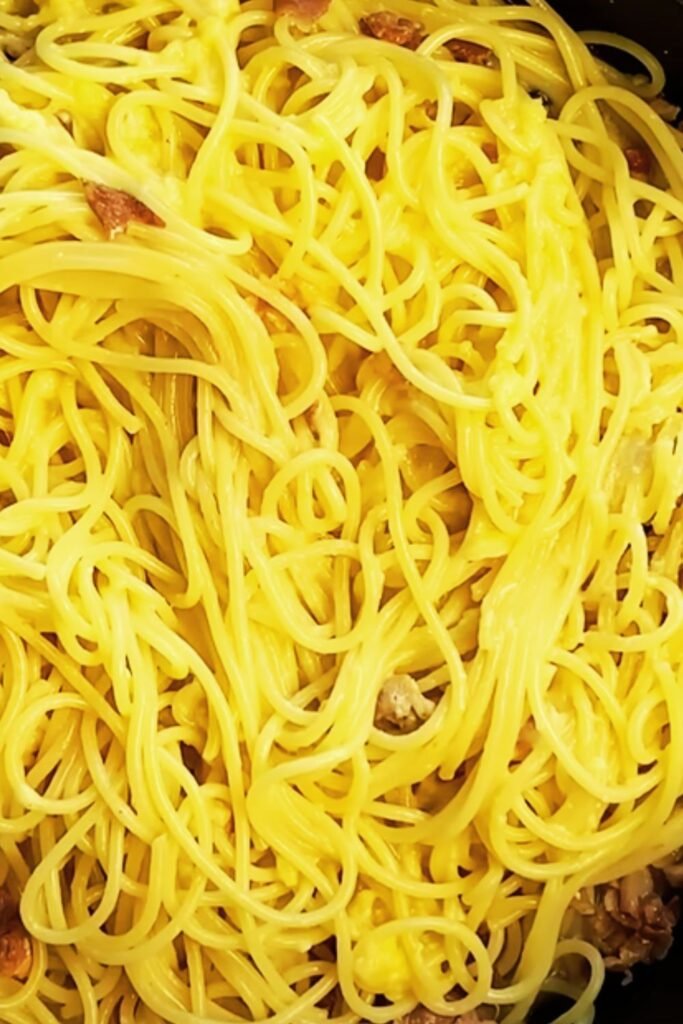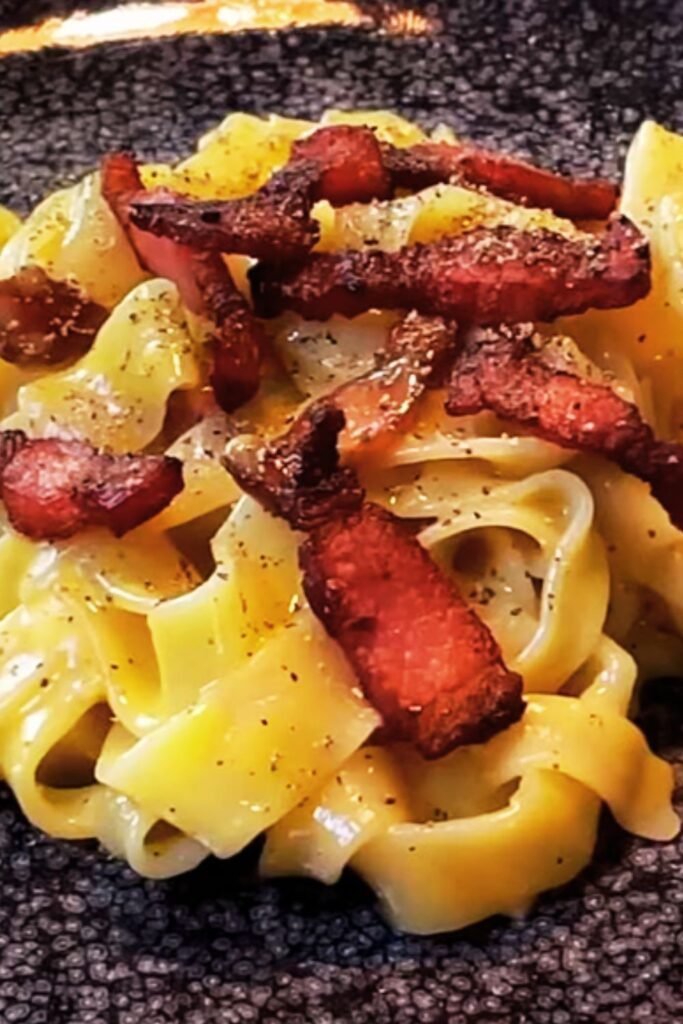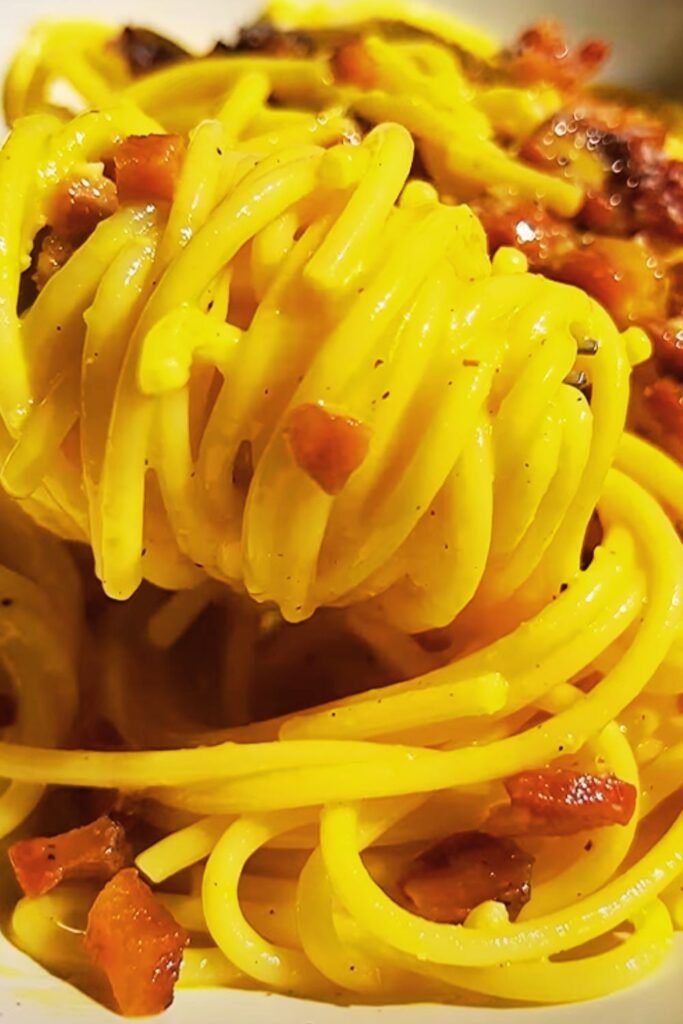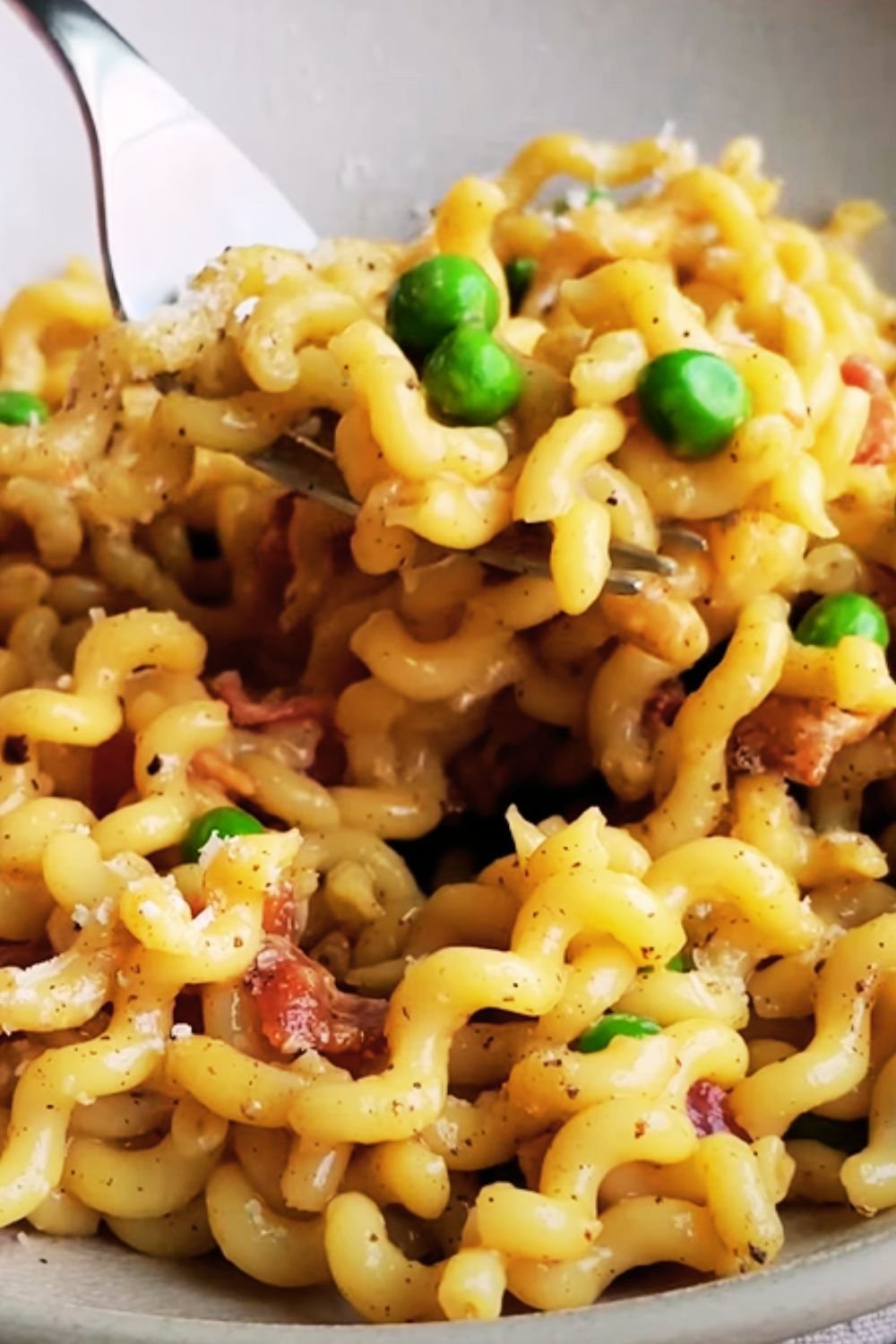Have you ever wanted to create a restaurant-quality pasta dish at home without spending hours in the kitchen? I’ve got you covered with this authentic 20-minute pasta carbonara recipe that will transport your taste buds straight to Rome. As someone who has tested hundreds of pasta recipes over the years, I can confidently say this carbonara is foolproof and delivers incredible flavor with minimal effort.
Carbonara is one of those magical dishes that transforms humble ingredients into something extraordinary. With just eggs, cheese, pancetta (or bacon), and pasta, you can create a silky, indulgent sauce that clings perfectly to every strand of spaghetti. No cream needed! This is the beauty of authentic Italian cooking – simple ingredients prepared with care and attention to detail.
Let me walk you through making this classic Roman dish step by step, with all the tips and tricks I’ve learned from Italian chefs along the way. Trust me, once you master carbonara, it will become your go-to impressive dinner that can be on the table in just 20 minutes.
What Makes Carbonara Special?
Carbonara is a traditional pasta dish from Rome that dates back to the mid-20th century. Its creamy texture comes not from heavy cream (a common misconception!) but from the magical combination of eggs and cheese that create a silky sauce when tossed with hot pasta.
Here’s what makes authentic carbonara so special:
- Simplicity: Just a handful of quality ingredients create an extraordinary dish
- Technique: The trick is in how you combine the ingredients to create a smooth sauce
- Balance: The perfect harmony between salty, savory pancetta and rich, creamy eggs
- Quickness: From start to finish in about 20 minutes
- Authenticity: A true taste of Rome without any unnecessary additions
Ingredients You’ll Need

For this 20-minute pasta carbonara, you’ll need just a handful of quality ingredients:
| Ingredient | Amount | Notes |
|---|---|---|
| Spaghetti or bucatini | 1 pound (454g) | Traditional choices for carbonara |
| Eggs | 4 large whole eggs + 2 egg yolks | Room temperature is best |
| Pecorino Romano cheese | 1 cup (about 3oz/85g) | Freshly grated, plus extra for serving |
| Pancetta | 8 oz (227g) | Diced; can substitute with guanciale or bacon |
| Garlic | 3-4 cloves | Minced or thinly sliced |
| Black pepper | 1-2 teaspoons | Freshly cracked, plus more for serving |
| Salt | To taste | For pasta water and final seasoning |
| Fresh parsley | 2 tablespoons | Chopped, for garnish (optional) |
Ingredient Notes and Substitutions
- Pasta: While spaghetti is traditional, bucatini (thick spaghetti with a hole running through the center) provides an excellent texture. You can also use rigatoni or fettuccine.
- Cheese: Authentic carbonara uses Pecorino Romano, which has a sharper, saltier flavor than Parmigiano-Reggiano. You can use a mix of both or substitute with Parmigiano-Reggiano if needed.
- Meat: Traditional Roman carbonara uses guanciale (cured pork jowl), but pancetta or good quality bacon make excellent substitutes.
- Eggs: Room temperature eggs blend more easily into a smooth sauce. The extra yolks add richness.
Essential Equipment
While carbonara doesn’t require any fancy equipment, having the right tools will make the process smoother:
- Large pot for boiling pasta
- Large skillet for cooking pancetta
- Tongs for transferring pasta
- Large heat-resistant mixing bowl
- Whisk for egg mixture
- Wooden spoon or silicone spatula
Step-by-Step Instructions
Here’s how to create the perfect carbonara in just 20 minutes:
1. Prepare the Egg Mixture
In a large heat-resistant bowl, whisk together:
- 4 whole eggs
- 2 egg yolks
- 1 cup freshly grated Pecorino Romano
- 1 teaspoon freshly ground black pepper
Whisk until well combined. This will be the base of your silky carbonara sauce. Set aside while you prepare the remaining ingredients.
2. Cook the Pancetta
- Heat a large skillet over medium heat
- Add the diced pancetta and cook until it’s crispy and has rendered its fat, about 5-7 minutes
- Add minced garlic in the last 30 seconds, stirring constantly to prevent burning
- Remove from heat and set aside
3. Cook the Pasta
- Bring a large pot of generously salted water to a rolling boil
- Add the spaghetti and cook until al dente, usually 1-2 minutes less than package instructions
- Important: Reserve about 1 cup of pasta cooking water before draining
4. Create the Carbonara Magic
This is the critical step that makes or breaks your carbonara:
- Do not drain pasta completely – use tongs to transfer it directly from the water to the skillet with pancetta
- Toss quickly to coat pasta with the rendered fat
- Remove skillet from heat
- Working quickly, add a splash (about 1/4 cup) of the reserved pasta water to the egg mixture while whisking
- Pour the tempered egg mixture over the pasta and toss continuously
- Add more pasta water as needed, a tablespoon at a time, until you achieve a silky, glossy sauce that clings to the pasta
5. Serve Immediately
- Divide pasta among warmed bowls
- Garnish with extra grated Pecorino Romano, freshly cracked black pepper, and chopped parsley if desired
- Serve immediately while hot

Secret Tips for Perfect Carbonara
After making carbonara countless times, I’ve discovered these game-changing tips:
- Temperature control is everything: Remove the pan from heat before adding the egg mixture to prevent scrambling
- Room temperature eggs: Cold eggs are more likely to curdle when they hit the hot pasta
- Pasta water is liquid gold: The starchy water helps emulsify the sauce and achieve that perfect silky texture
- Work quickly: Have everything ready before draining the pasta, and serve immediately
- Never add cream: Authentic carbonara gets its creaminess from eggs and cheese alone
- Salt carefully: Both the pancetta and Pecorino are quite salty, so taste before adding additional salt
- Don’t skimp on the pepper: Freshly cracked black pepper is essential to the flavor profile
Troubleshooting Common Carbonara Problems
Even experienced cooks can run into issues with carbonara. Here’s how to solve them:
| Problem | Likely Cause | Solution |
|---|---|---|
| Scrambled eggs instead of sauce | Too much heat when adding eggs | Remove pan from heat completely before adding egg mixture |
| Sauce too thick | Not enough pasta water | Add pasta water a tablespoon at a time until silky |
| Sauce too thin | Too much pasta water | Continue tossing; it will thicken as it cools slightly |
| Bland flavor | Insufficient seasoning | Add more black pepper and Pecorino Romano |
| Pasta clumping together | Not tossing quickly enough | Use tongs to keep pasta moving constantly while saucing |
Nutritional Information
For those keeping track of nutritional content, here’s the approximate breakdown per serving (recipe serves 4):
| Nutrient | Amount per Serving |
|---|---|
| Calories | 650 |
| Protein | 29g |
| Carbohydrates | 65g |
| Fat | 30g |
| Fiber | 3g |
| Sodium | 890mg |
Variations to Try
While the classic carbonara is perfect as is, here are some delicious variations to experiment with:
Carbonara with Vegetables
Add sautéed asparagus tips, peas, or zucchini for a pop of color and nutrition.
Seafood Carbonara
Replace pancetta with sautéed shrimp for a delicious seafood twist.
Mushroom Carbonara
Add sautéed wild mushrooms for an umami boost and vegetarian option (skip the pancetta).
Spicy Carbonara
Add a pinch of red pepper flakes to the pancetta while cooking for a subtle heat.
Serving Suggestions

Carbonara is rich and satisfying on its own, but these sides complement it beautifully:
- Simple green salad with a light lemon vinaigrette to cut through the richness
- Crusty Italian bread or garlic bread for mopping up every last bit of sauce
- Roasted vegetables like broccoli, Brussels sprouts, or asparagus
- Lemon sorbet as a refreshing palate cleanser for dessert
- Sparkling water with lemon to cleanse the palate between bites
Make-Ahead and Storage Tips
Carbonara is best enjoyed immediately after preparation, but if needed:
- Prep ahead: Cook the pancetta and prepare the egg mixture up to 1 day ahead. Store separately in the refrigerator.
- Leftovers: Store in an airtight container in the refrigerator for up to 2 days. The texture won’t be as creamy when reheated.
- Reheating: Add a splash of water and reheat gently in a skillet over low heat, stirring constantly.
- Freezing: Not recommended, as the sauce will separate when thawed.
Why This Recipe Works
What makes this carbonara recipe foolproof is the attention to crucial details:
- Tempered eggs: Adding hot pasta water to the eggs before combining with pasta prevents curdling
- Perfect pasta: Cooking the pasta al dente ensures it doesn’t get mushy when tossed with the sauce
- Reserved pasta water: The starchy water creates silky emulsion with the fat from pancetta
- Proper heat management: Removing the pan from heat prevents scrambling the eggs
- Quality ingredients: Using genuine Pecorino Romano and good pancetta guarantees authentic flavor
Frequently Asked Questions
Can I make carbonara without eggs? No, eggs are essential to authentic carbonara. The eggs create the creamy sauce that defines the dish.
Is it safe to eat carbonara since the eggs aren’t fully cooked? The heat from the pasta cooks the eggs enough to be safe while maintaining the creamy texture. If you’re concerned, use pasteurized eggs.
What’s the difference between Alfredo and carbonara? Alfredo sauce is made with butter and cream, while carbonara sauce comes from eggs and cheese. Carbonara also includes pancetta or bacon for a smoky, savory element.
Can I use pre-grated cheese? For best results, grate the cheese yourself just before using. Pre-grated cheese often contains anti-caking agents that can make your sauce grainy.
Why did my eggs scramble instead of forming a sauce? Your pan was likely too hot when you added the egg mixture. Always remove the pan from heat and let it cool slightly before adding the eggs.
Can I make carbonara with gluten-free pasta? Yes! Use your favorite gluten-free pasta, but note that you may need to adjust the amount of pasta water to achieve the right consistency.
What does “carbonara” mean? The name carbonara comes from “carbonaro,” the Italian word for charcoal burner. One theory suggests the dish was popular among Italian charcoal workers.
Can I add cream to make it creamier? Traditional carbonara doesn’t use cream. The creaminess comes from the eggs and cheese. If the sauce is properly emulsified with pasta water, it will be plenty creamy.
A Personal Note
I’ll never forget the first time I had authentic carbonara in a tiny trattoria in Rome. The waiter brought out a simple plate of pasta that looked almost too basic to be impressive, but that first bite was a revelation. The silky sauce, the perfect balance of salt and pepper, the rich eggs complementing the savory pancetta – it changed my understanding of what pasta could be.
After returning home, I spent months perfecting this recipe to recreate that magical moment. This 20-minute version captures all the authenticity of that Roman experience but fits into our busy lives. I hope it brings a little taste of Italy to your dinner table, proving that extraordinary meals don’t require extraordinary effort – just good ingredients and a little know-how.
Buon appetito!


